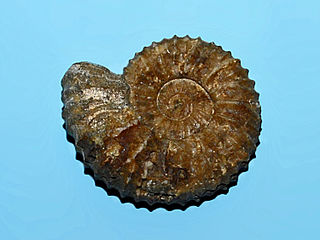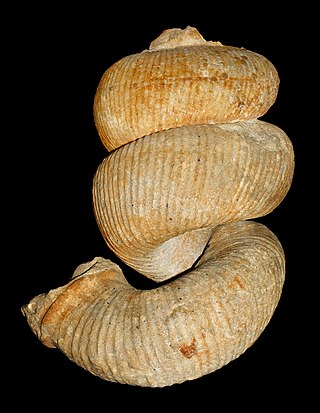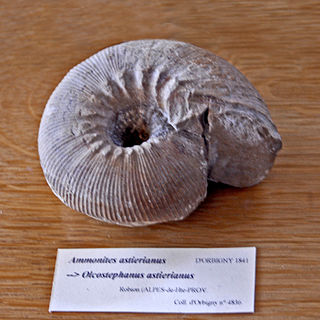
Australiceras is an extinct ammonite genus from the upper part of the Early Cretaceous, Aptian stage, included in the family Ancyloceratidae.
Karapadites is an extinct ammonoid genus belonging to the desmoceratacean family Kossmaticeratidae and considered by some to be a subgenus of Kossmaticeras.
Algerites is middle Cretaceous (Cenomanian) anisoceratid ammonoid with a close-coiled adult shell in which the whorls at that stage are in close contact, after starting off with openly coiled whorls, and in which every rib has a pair of sharp ventral tubercles.

Ammonoceratites is an extinct genus of ammonoid cephalopod known from the Albian of British Columbia, Madagascar, New Zealand, and Japan, included in the Lytoceratidae.
Astreptoceras is an extinct upper Cretaceous ammonoid cephalopod named by Henderson in 1970. Fossils belonging to this genera have been found in Antarctica and New Zealand.

Argonauticeras is an extinct ammonoid cephalopod genus that lived during the latter part of the Early Cretaceous, included in the Lytoceratida and found in lower and possibly middle Aptian marine sediments. It has been thought of as a subgenus of Ammonoceratites.
Baronnites is an ammonoid cephalopod from the upper Valanginian stage of the Lower Cretaceous. Baronnites is represented by a single species, Baronnites hirsutus found in marine silty to sandy limestone and marl in Morocco, associated with another ammonoid, Busnardoites campylotoxus, brachiopods, bivalves, and other invertebrates.

Barremites is an ammonoid cephalopod genus belonging to the family Desmoceratidae, that lived during the Hauterivian and Barremian stages of the Early Cretaceous.
Anisoceratidae is an extinct family of heteromorph ammonites which belong to the Ancyloceratina superfamily Turrilitoidea. Members of the family range is from the lower Albian to the upper Turonian. The family is possibly derived from a member of the Hamitidae.

Pavlovia is an extinct genus of ammonite of the Late Jurassic to Late Cretaceous.

Bostrychoceras is a genus of heteromorph ammonite from the family Nostoceratidae. Fossils have been found in Late Cretaceous sediments in Europe and North America.

Phylloceras is an extinct genus of ammonoid cephalopods belonging to the family Phylloceratidae. These nektonic carnivores lived from Early Jurassic to Late Cretaceous.

Peroniceras is an ammonite belonging to the Ammonitida family Collignoniceratidae.

Lewesiceras is a genus of large ammonites belonging to the order Ammonitida and the family Pachydiscidae.

Lytoceratinae is a subfamily of ammonoid cephalopods that make up part of the family Lytoceratidae.

Protetragonites is an extinct genus of ammonoid cephalopods belonging to the family Lytoceratidae. These fast-moving nektonic carnivores lived from the Jurassic period Tithonian age to the Cretaceous period Aptian age.

Eulytoceras is an extinct genus of ammonoid cephalopods belonging to the family Lytoceratidae. These fast-moving nektonic carnivores lived in the Cretaceous period, from Hauterivian age to Barremian age.

Kossmatella is an extinct genus of ammonoid cephalopods belonging to the family Lytoceratidae. These fast-moving nektonic carnivores lived in the Cretaceous period, from Albian age to Cenomanian age.

Oosterella is an extinct ammonoid cephalopod genus belonging to the family Oosterellidae. These fast-moving nektonic carnivores lived during the Cretaceous, from the upper Valanginian age to the lower Hauterivian age.

Olcostephanus is an extinct ammonoid cephalopod genus belonging to the family Olcostephanidae. These fast-moving nektonic carnivores lived during the Cretaceous, from the upper Valanginian to the lower Hauterivian age.














